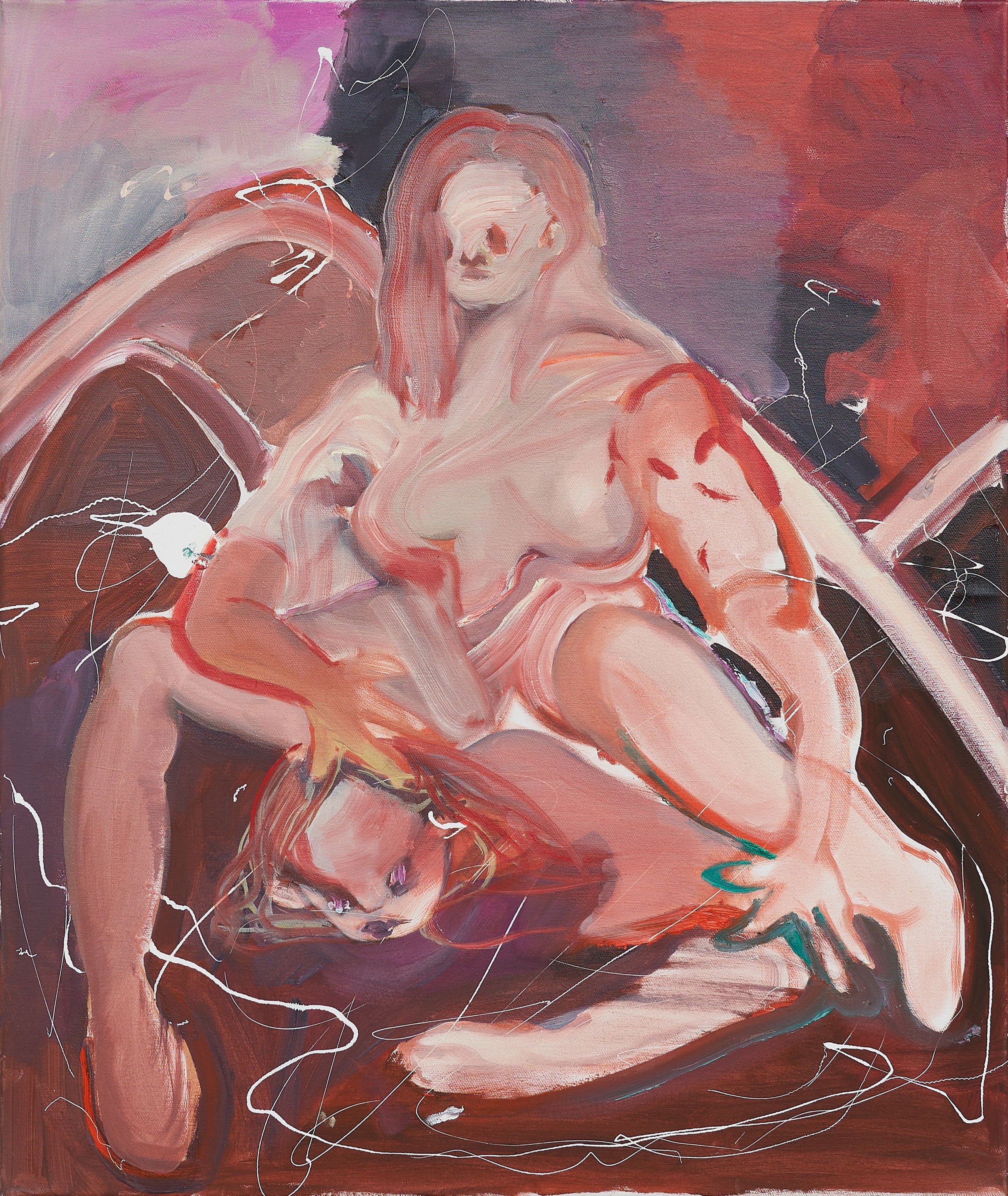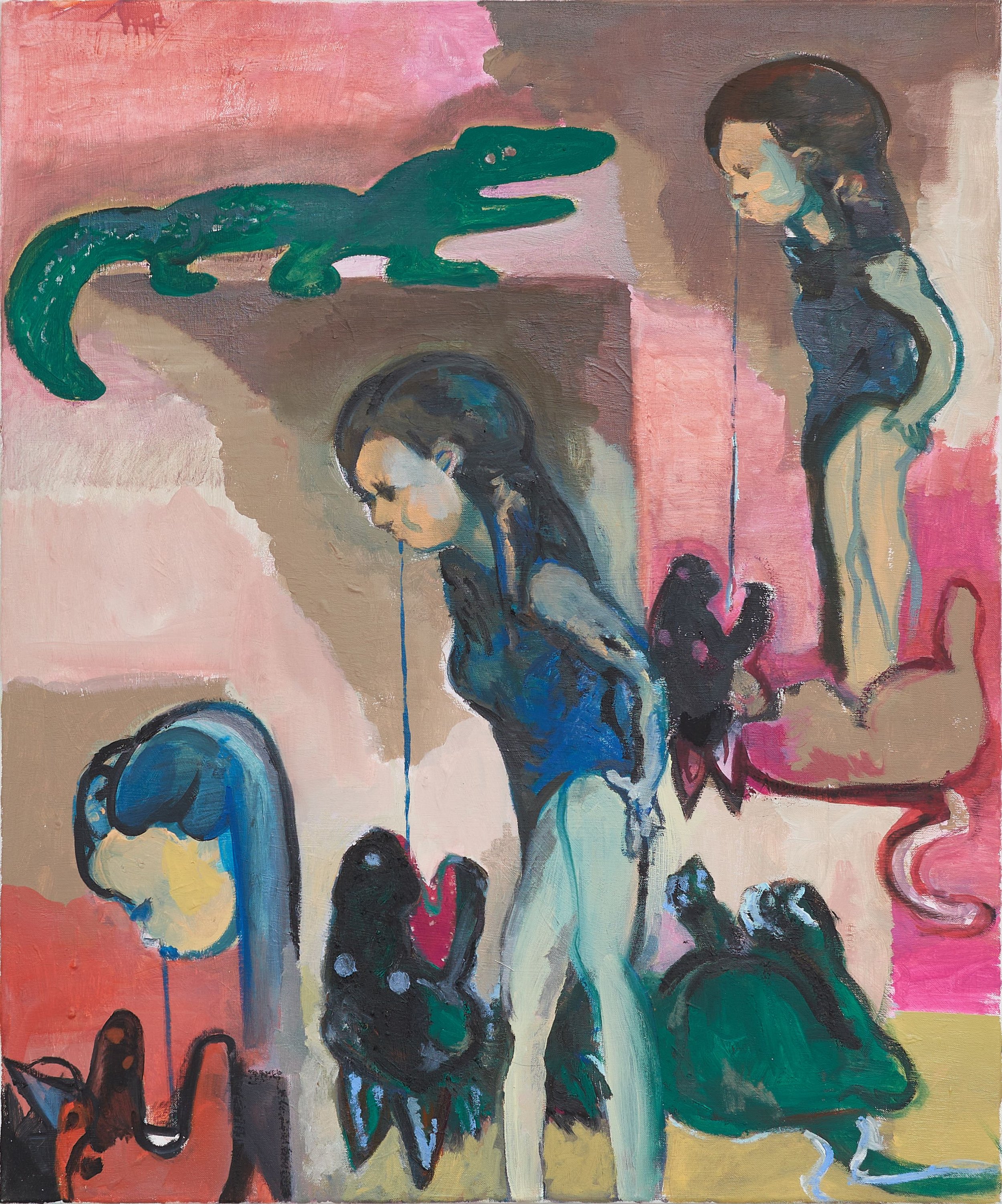Chiao-Han Chueh—“The Warning Light”







Exhibition
For the solo show at Nunu Fine Arts this July, Chiao-Han Chueh prepares a group of works featuring skin tones, such as pink, orange and red. The paintings portray mostly female figures, who behave freely in fantastical spaces. A woman rides on another person. She reaches her hand out to subdue the woman under her, who protests and raises her head in extreme anger. Three fashionable women, with flawless smiles, cling to a gigantic phallic object. They seem to float upward, with one of them stepping on a mushroom. In Chiao-Han’s paintings, vivid colors and dynamic lines form images that are both playful and suspenseful. Titled by Chiao-Han, “The Warning Light,” the name of the exhibition refers to the mental and physical impulse that elicits a sense of danger. Such impulse originates from the instinctive feeling of the painter at the moment she takes up the brush, which is then communicated to the viewer through the lines and imageries of the paintings.
Dynamic Brushstrokes—Chiao-Han Chueh's Creative Methods
ChiaoHan uses a variety of mediums to paint, such as acrylic, oil paint, paint and spray paint. Coarse or extreme wet strokes form dynamic yet blurry images. The backgrounds of the images show traces of wide brush going back and forth. Areas of different colors blur and morph together on the borders. Chiao-Han enjoys using contrast colors to enhance visual stimulation. She would reinforce certain parts with linear strokes for finishing, “just like highlighting the notes”. She applies fast and long strokes to delineate bodies whose simple gestures express strong force. Some of the hands, arms and legs grow beyond the human physiognomy, twisting and intertwining with each other. Chiao-Han says that when she paints, she lets the visual and psychological impulses she feels from the canvas lead the brush, transforming the qualities of various mediums. A stroke that started as constituting part of a body may turn into a hair, as the perception of the brush on the canvas changes. In Dancing with Pigs, When the Wealth Falls From the Sky, elaborate lines on thewoman’s torso form a shape that resembles the head of a horse. It is hard to decipher how the woman’s body and the horse’s head morph together, but the interaction of the two makes the viewer loses in reverie. Chiao-Han explains that she was painting the leg of the woman; however, as the creative process continued, these lines eventually turned into a shape that many viewers identify as the head of a horse. In The Enemy Died before Me I, an angry face seems to float on the arm of the woman. It is impossible to explain the presence of this face with common knowledge; nevertheless, one cannot deny the dramatic tension generated by this face.
Chiao-Han says, “if I feel the space of the composition is complete, I stop painting, even if the objects in the painting remain incomplete.” In her paintings, the force and expressive will of the line overwhelm the need to portray human figures accurately or to create an image that conforms to logic. Images created under such methods are often not perfect or beautiful. As Chiao-Han says, “I especially like the ugly pictures because these pictures show the process of creation truthfully and retain the original idea.” The truthfulness that the artist wishes to express so eagerly pertains to the child’s perception and understanding of the world. As Chiao-Han comments, “the naive point of view, observation from the childhood, and the wild and smooth brushstrokes” are what she pursues in her paintings.
Naive and Dangerous Childhood Fantasies— Chiao-Han Chueh’s Inspiration
Facing the unknown world as children, our minds are filled with imagined adventures. Recalling these childhood fantasies, Chiao-Han “creates cartoonish nightmares with naivety and humor.” For her, “such ways of seeing may be the truth as we set aside the habitual visual framing. With the childish expectations of the paintings, the world of fairytales may be true.” There are often dangerous and unnerving situations in Chiao-Han’s paintings— somebody falls off the cliff, somebody is running away, and somebody is in close contact with animals. The settings contain rich narrativity and a suspenseful atmosphere. The story hangs at a crucial moment, making one wonders what is going to happen. In Dancing with Pigs, why is the little pig smiling so wickedly? Why do gold coins fall from the sky? In Girls in Video Games are Falling III, the woman on the cliff and the other woman below hold each other's breasts. The enlarged hands show the force of the grips, but the hands seem to be slipping away. Can the woman on the cliff save the others, or will she fall? In The Saliva, three girls (or three perspectives on the same event) stand along the diagonal line of the canvas. The girls look down, and lines extend from their mouths to the animals at their feet. The animals lay flat on the ground with their backs and wave their limbs in the air. With sharp teeth in their wide-open mouths, the girls seem to put themselves in a dangerous situation. However, their concentrated and calm expressions make one wonder what they plan to do. Chiao-Han mentions that when she painted this painting, she was thinking of the idea of spitting toward an animal. Facing dying animals, the girls attempt to save them by spitting the saliva on the animals to provide water. They hope to connect with or save these animals in vain. This ridiculous and futile idea reminds the viewer of the fairytales in which Snow White is saved by a kiss and the frog turns into the prince with a kiss.
Animals such as fish, amphibians, butterflies and birds often occur in Chiao-Han’s paintings. As a child, the artist took time to observe various creatures, especially those hated by humans, like rats and parasites. Such visual experience cast aside by the modern life becomes her inspiration, “to survive, the animals do not restrain their body language… whether in fear or relaxation, their conditions can be easily perceived,” says Chiao-Han. The presence of animals gives a fantastic and dangerous atmosphere to the paintings. Moreover, Chiao-Han equips her human figures with the primitive and truthful condition of the animal bodies. In her paintings, human characters interact intimately with animals. Someone is kissed by a frog, someone has a pillow talk with the fish, and someone plays with a cat that returns from a hunt with her naked and soft body. In Chasing Carrots, three girls lower their bodies to touch the running track, like hunting leopards. Their eyes focus on the three carrots in front, showing the primitive desire for food.
Unrestrained Bodies Expressing Desires— Chiao-Han Chueh’s Human Figures
The carrots and plums on the other end of the running track are not merely food but symbols of desire. As humans turn into animals, they no longer need to conceal their facial expressions and body language to hide their desires. The woman dancing with the pig smiles greedily. The three women who worship the phallic object press their bodies close to the giant object. The girl climbing up the stairs is not afraid of the danger. She only wants to catch the desired object in the air. In these narratives flows the undercurrent of desire. The characters possess innate impulses and they act according to their desires. The desires may be related to sexual and materialistic pursuits. The desires could also be intimate and personal, which can only be comprehended by the characters. The women do not seem to take care about how the audience views their bodies. They do not even pay attention to the presence or absence of the audience. The woman on the cliff does not feel shame as she opens her leg widely. She and the others only care about how to escape from the situation and save each other. In Naked Sushi, two female bodies spread out in relaxation. The larger one occupies the composition. One hand rests on the torso and the other hand feels the gentle hair. The desire, sushi and colorful background allude to the mental states of the figures. The human figures in Chiao-Han’s paintings openly follow and pursue their desires. Their behaviors are unrestrained; therefore, they can be in their own skins comfortably and display their bodies at will.
Growing up as a child, Chiao-Han was quite affected by the rules of gender norms. A girl is required to protect her body with adequate clothing. Such childhood experience makes Chiao-Han especially conscious of her own body. As a result, again and again, she breaks the social constraints on the body in her paintings. The return to children’s perception and the evocation of animal-like bodies are ways to recall and transcend the painter’s childhood memories.
The unrestrained body constitutes the core of Chiao-Han’s art. Freedom is not just expressed in the final paintings, but realized from the moment the painter feels the desire to paint and takes up the brush. When she paints, Chiao-Han avoids over-thinking, since over-thinking leads to embellishment, causing the image to lose its natural appearance. Chiao-Han paints with an imagined story plot that comes up in her mind at the moment she starts to paint, without having a careful and intricate plan. She focuses on the momentum felt from the image. Likewise, her brushstrokes express speed and flowing undulation. Chiao-Han cares very much about using the brush to depict swift bodily movements that happen in an instant, such as running, falling and subduing the enemy. The corporeal feelings triggered by such swift actions are too short to be analyzed with logic or described by language. These feelings only exist in the subconscious. Chiao-Han’s paintings direct the viewer’s attention to the corporeal feelings created by instantaneous movement. Looking at these paintings, the viewer regains the intimate connection with one's own body, tasting the sense of freedom.
Artist

